The Main Differences Between Cayenne And Chili Powder

There are many ways to incorporate spicy flavors into a meal, but picking up a few seasonings is one popular option. There are so many different spices to choose from, some of which feel like more of the same thing. Still, don't be fooled; even the spices that seem interchangeable are most likely not. One prime example? Cayenne and chili powder.
While both firey toppings boast intense red hues and dry, peppery flavors, there are a few significant differences between the two. For starters, similar to paprika, cayenne powder is made up exclusively of ground cayenne peppers. Chili powder, on the other hand, is a combination of a few different dried chilis, including cayenne, as well as some mild ingredients, such as cumin and oregano. This means that cayenne powder will lend a much hotter red pepper flavor than chili powder, often falling between 30,000 to 50,000 on the Scoville scale, while chili powder will have a more well-rounded Tex-Mex flavor with much milder heat levels.
Looking beyond taste, this also means cayenne powder has more consistent orangey-red hues, while chili powder will have a mix of different colors depending on what's inside. The flavor and intensity of both of these powders vary by brand, but overall, cayenne powders are much hotter than chili powders, so you should use that particular spice in moderation.
Read more: French Cooking Tricks You Need In Your Life
The Origins Of These Popular Powders

Tastes of these spices aside, the differences in the makeup of cayenne and chili powder also contribute to some vast discrepancies in their shelf life. Because chili powder has more ingredients, it might not last as long in your pantry, so keep a close eye on its best-by date.
Beyond the ingredients, there's another big thing that sets them apart, and that is their sources. Cayenne powder originates in Cayenne, French Guiana, from the cayenne pepper plant. Spanish explorers brought the plant to Europe, where it impressed people with its adaptability and slowly began to spread worldwide. It was used to make anything from powders to red pepper flakes. Chili powder, on the other hand, has its roots in Texas. While the initial inventor of this spice blend is up for debate, we know that it came about sometime in the late 1800s as an attempt to recreate a mixture used by the Aztec empire.
While these spices come from different regions, they are both enjoyed all over the world in dishes ranging from aromatic Chana Dal to tangy and fresh Elote. There's really no limit to how and where you can use these spices. So, if you're eager to taste the differences, here are some meals in which you can try these beloved seasonings next.
How To Use These Spices To Heat Up Your Favorites

Both cayenne and chili powder can infuse any dish with heat. Still, since cayenne pepper is much more pungent, it's best to sprinkle this one on sparingly. Chili powder is a more well-rounded blend, so you can use it generously. Then, if you enjoy the flavor of both of these, you can add a few dashes more.
Cayenne and chili powder both taste wonderful mixed into equally bold dishes that will match the intensity of these spices, so thick, meaty stews and savory chilis are fair game. Adding a dash of cayenne could also work wonders in unexpected things like sweet beverages, from hot chocolate to lattes. Much like salt, adding a spicy topping to a sweet dish makes for a more well-rounded flavor, and the unique notes within each ingredient will be emphasized even more.
When it comes to chili powder, you can use this spice blend as a rub for grilled meats or fish or in Mexican cuisine to flavor anything from fajitas to tacos. Lastly, these vibrant toppings can also add a punch of color to any dish, so they're helpful in aesthetic conditions, too. If you're curious about other spicy ingredients in your pantry, learn the difference between chili powder and chile powder next.
Read the original article on Daily Meal

 Yahoo Movies
Yahoo Movies 
